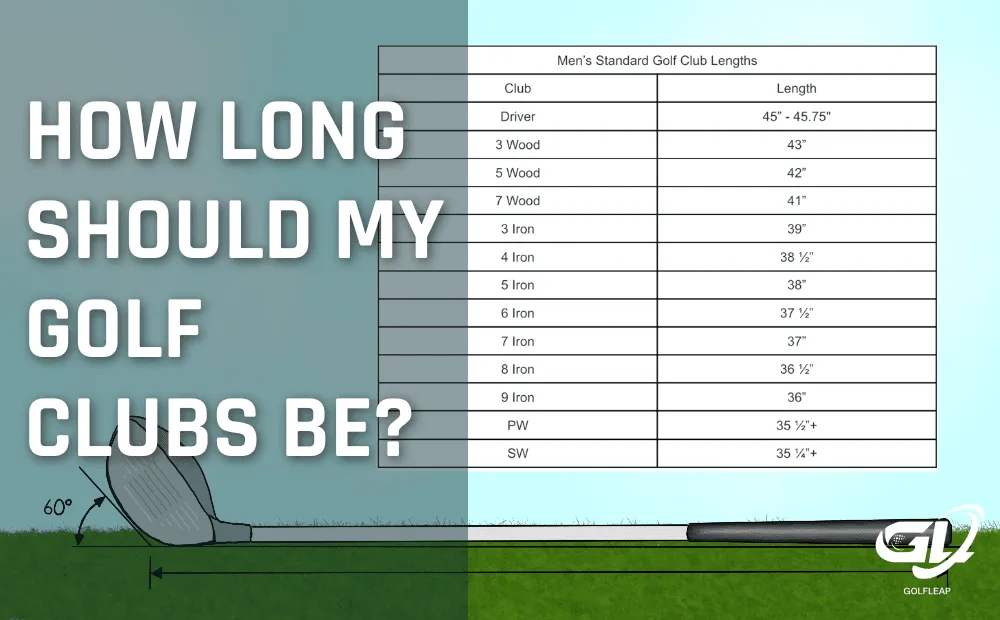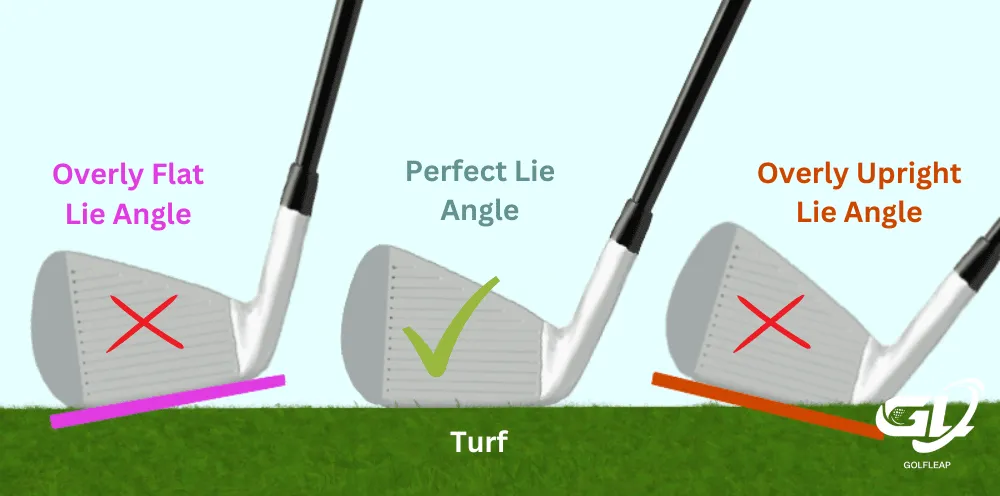
Learn What Length Your Golf Clubs Should Be Today!
Have you decided it’s time to upgrade your equipment? Whether the reason be your skill level has evolved to exceed your clubs’ potential, or you’ve just grown in height or size, deciding how long your golf clubs should be isn’t as simply answered as looking at your height alone.
The problem with purchasing sets of clubs or individual clubs right out of the store is they are built to “standard size” specifications that will only truly “fit” a small portion of the golfing population.
As a near-scratch level golfer whose body changed a lot in the last few years and went through the professional fitting process recently, I was amazed to see all the different factors that influenced the size and length of my clubs.
Our in-depth breakdown below will cover every factor golfers need to determine what will find them their best-fitting golf clubs.
Make sure you stick around until the end of our discussion, where we answer some of our reader’s most commonly asked questions about the right golf club length!
Table of Contents
Measurement #1: Wrist-to-Floor Measurement (WTF)
Just within the last 15 years, the custom golf club fitting process has become mainstream to the general golfing public.
Where previously only elite-level golfers and touring professionals might have thought individual club fitting was important, now players of every skill level are beginning to see the benefits of having equipment designed for their specific frame and swing.
One of the most crucial measurements in this fitting process is your “Wrist to Floor Measurement” (WTF).
A golfer’s wrist-to-floor measurement is a key indicator to a club fitter (along with a player’s height) to determine the correct club length and lie angle for each individual golfer (we’ll touch on lie angle later).
But just as everything else with golf is complicated, a golfer’s wrist-to-floor measurement isn’t as simple as just measuring the distance from your wrist to the floor!
How to Measure Your Wrist-to-Floor Measurement
Tools You’ll Need: Flat Surface for Standing, Tennis or Golf Shoes, Yard-Stick or a Long Measuring Stick
- Begin by standing tall on a perfectly flat surface making sure you have your golf shoes on or a pair of tennis shoes of around equal sole height
- Take your measuring device and place it beside your non-dominant leg, running vertically along your side up to your waist area
- Take your non-dominant hand and curl your fingertips like you’re holding a bucket in these digits, paying particular attention to the second knuckle on your middle finger
- Standing up straight, wherever the second knuckle of your middle finger rests on your measuring device at your side is your wrist-to-floor measurement
We measure the distance from our non-dominant hand’s middle knuckle of the middle finger to the floor because this is considered as close to the “middle” of your grip as possible.
For the convenience of our readers, we’ve included a conventionally used “Wrist-to-Floor Measurement Chart” so you can see what club length adjustments are most common based on your wrist-to-floor measurements.
| Male Height (Feet/Inches) | Estimated Wrist-to-Floor Measurements | Estimated Club Length Adjustment |
| 6’8” | > 42” | Add 2” |
| 6’6” – 6’8” | 41” – 42” | Add 1 ½” |
| 6’4” – 6’6” | 40” – 41” | Add 1” |
| 6’2” – 6’4” | 38.5” – 40” | Add ½” |
| 6’1” – 6’2” | 37” – 38.5” | Add ¼” |
| 5’7” – 6’1” | 34” – 37” | Standard |
| 5’4” – 5’7” | 32” – 34” | Subtract ¼” |
| 5’2” – 5’4” | 29” – 34” | Subtract ½” |
| 5’0”, 5’2” | 27” – 29” | Subtract 1” |
| 4’10” – 5’0” | 25” – 27” | Subtract 1 ½” |
| < 4’10” | < 25” | Subtract 2” |
For example, I am 5’11” but my arms are long for my height, making my wrist-to-floor measurement 32 inches.
If we went off height alone, I could be in a world of hurt in terms of “properly fitted” golf clubs!
Measurement #2: Club Length Based on Height
The most basic and commonly used method of determining the right length clubs for a golfer is by using a “Height-Based Chart.”
We already determined this shouldn’t be the only factor used when deciding the length of your next set of new golf clubs, but regardless, this measurement is important to a professional club fitter and the golf club manufacturers as each length of club were designed with a different player in mind.
The “average height” for a female in the United States is currently 5’4”, and the “average height” for a male is 5’9”. These are the measurements most major club manufacturers build their “standard length” golf club sets based on.
For the convenience of our readers, we’ve included our rendition of some of the most commonly used “Height vs. Recommended Club Length” charts below.
| Male Height (Feet/Inches) | Estimated Club Length Adjustment |
| 6’8”+ | Add 2” |
| 6’6” – 6’8” | Add 1 ½” |
| 6’4” – 6’6” | Add 1” |
| 6’2” – 6’4” | Add ½” |
| 6’1” – 6’2” | Add ¼” |
| 5’7” – 6’1” | Standard |
| 5’4” – 5’7” | Subtract ¼” |
| 5’2” – 5’4” | Subtract ½” |
| 5’0” – 5’2” | Subtract 1” |
| 4’10” – 5’0” | Subtract 1 ½” |
| <4’10” | Subtract 2” |
As you can clearly tell from our chart above, adding just 1 inch of length to the “standard” club lengths from the manufacturer would make a male’s estimated height between 6’4” and 6’6”, a tiny fraction of the world’s population (<1%).
How Do These Two Measurements Help My Club-Fitting Process? Defining “Static” vs. “Dynamic Club Fitting”
Both your Wrist-to-Floor Measurement and Height Measurement are defined as “Static Fitting Measurements” in the golf club fitting world.
Static means “stationary” and Dynamic means “in movement.”
These measurements can be taken without having to see a golfer’s swing, and provide a club fitter or a golfer with an estimation and “general idea” as to what length and lie angle a golfers’ clubs should be.
Knowing these two static measurements when purchasing a new set of clubs is better than nothing, but doesn’t compare to the benefits of an additional “Dynamic Club Fitting.”
A Dynamic Club Fitting uses a golfer’s ball flight, impact, and feeling of strike to determine the proper length, lie, shaft, and loft angle of your golf clubs to ensure they match your specific swing and bodily requirements to give you the most consistent results.
A professional fitter with a lot of experience will be able to look at your ball flight and determine if anything needs to change (Example: “Is the ball flight consistent? Too low or too high? Is the ball curving too much in the air?”).
A professional club fitter’s expertise, combined with quantifiable data from a launch monitor provides the proper data points needed for further shaft, lie angle, and clubhead recommendations.
Getting a Professional Club Fitting? Here’s What We Do and Recommend to Others:
Taking your golf bag and game to the next level through a club fitting? Wondering if a Static Fitting or a Dynamic Fitting is the best?
In reality, both Static and Dynamic Fitting combined will give the greatest results in fitting a golfer with the right equipment, and a qualified expert in the field that truly cares (while sometimes difficult to find) will know how to combine these data points to find the best club solution for you.
They’ll begin with the Static Measurements to find a “starting point” for the length and lie.
After watching your swing and the results of each swing (Dynamic Measurements), the fitter will get a better idea of the flex and weight of the shaft and clubhead you need.
Lastly, after checking a player’s impact location in relation to the center of the clubface, the professional will make any adjustments on the lie angle to make sure the ball is flying as straight as it can (or seeing the ball flight you want).
Importance of Finding the Correct “Lie Angle”

While it might sound like a way of not telling the truth, your golf clubs’ “Lie Angles” are actually another static measurement that plays a massive role in the accuracy of your golf shots.
Your lie angle is the angle formed between the center of the shaft and the sole of the club, or where and how your club rests behind the golf ball with your normal posture and stance.
One of the goals of a professional club fitting is making sure the lie angle of your golf clubs produces the greatest chances of you hitting the center of the clubface with your normal golf swing.
Results of Too Flat of Lie Angle
If the lie angle of your irons is too flat (far left portion of our above illustration) the toe of your irons will dig too sharply into the ground while you’re making contact, resulting in inconsistency of strike, more shots that end up left of your intended target, and more thin shots hit low off the clubface.
Results of Too Upright of Lie Angle
If the lie angle of your irons is too upright (far right portion of our illustration) the heel of your irons will dig into the ground too harshly while you’re making contact, causing chunks, flared shots to the right of your target, and tons of lost distance from inconsistent clubface contact.
It’s said that just 1 degree of incorrect lie angle (either too flat or too upright) will cause a golfer’s shot to end up 4 yards off-line of the intended target.
Final Thoughts on Lie Angle
We believe the importance of finding the proper lie angle gives more credit to the importance of a dynamic fitting when purchasing new golf clubs. If you can’t see how your club is interacting with the turf and the golf ball, you’ll never be 100% sure you have the best lie angle for your swing.
Additionally, if you’re hitting the ball exactly how you intend to but aren’t seeing the results you’re looking for, or you plan on purchasing a set of clubs used from someone else, take your clubs to a professional club fitter or specialist that has the proper tools to test your loft and lie angles.
These very crucial angles can change and shift on their own from traveling, being hit frequently, or bouncing around in the golf cart.
If they are tested and aren’t where they should be for your swing, a trained professional can bend your clubs back to the correct loft and lie angles.
Effects of Changing Shaft Length on Shaft Stiffness
While we wish shaft length adjustments were as simple as cutting off a portion or adding a bit of length to the handle, changing the length of a shaft changes its stiffness pretty dramatically depending on how much you’re adding or subtracting.
If you think about it, it makes a ton of sense. What are we hoping to accomplish when we grip down on a club? Usually a lower ball flight, less distance than a normal swing, and more accuracy.
When a shaft gets trimmed from its normal length, it becomes stiffer at the same time. A consequence of this is the club head won’t be able to develop as much speed or have as great of a “whipping motion” during the downswing, generally resulting in a lower ball flight with less distance.
Extending a golf clubs shaft, while it might make a club feel more comfortable in your hands if you’re a taller golfer, can influence the shaft by making it weaker and “whippy-er” during the downswing, increasing clubhead speed and distance for some but losing control and accuracy for most others.
*Note from the Author* Do NOT change your shaft length yourself. For every ½” of length added to a club, the lie angle gets shifted 1 degree upright, and for every ½” of length removed the opposite is true.
If you truly believe an adjustment to the length of your club shafts will help you find greater accuracy or distance, find a professional that has the proper tools and resources to do the job for you, as you could render a club useless by doing it yourself incorrectly.
What Are “Standard Length” Golf Clubs? Who Do They Fit?
We’ve already determined that “Standard Length” clubs won’t fit everybody, but they wouldn’t be called “Standard Length” if they didn’t fit some golfer’s frames and swings.
While we’ll always encourage a Static and Dynamic Fitting to make 100% sure you’re in the proper club lengths, shaft stiffness, and lie angles, we’ve included a chart below that displays the most common “Standard Club Lengths” from major manufacturers.
If you’re between the heights of 5’7” and roughly 6’0”-6’1”, these are the “standard heights” standard length clubs are designed to cater towards.
*NOTE* Standard lengths can change from manufacturer to manufacturer and depending on their country of origin.
| Men’s Standard Golf Club Lengths | |
| Club Type | Length |
| Driver | 45” – 45.75″ |
| 3 Wood | 43” |
| 5 Wood | 42” |
| 7 Wood | 41” |
| 3 Iron | 39” |
| 4 Iron | 38 ½” |
| 5 Iron | 38” |
| 6 Iron | 37 ½” |
| 7 Iron | 37” |
| 8 Iron | 36 ½” |
| 9 Iron | 36” |
| PW | 35 ½”+ |
| SW | 35 ¼”+ |
Cons of the Wrong Size Clubs
We’ve explained that having the correct length clubs for your specific body and swing are crucial, but we haven’t fully explained all the problems that can occur when you don’t have the correct size.
Issues that arise from using the wrong length clubs include:
- Increased likelihood of developing the wrong swing habits.
By having clubs that are too short, your posture will be influenced to correct for the clubs length, you’ll crouch too much during impact causing inconsistent striking patterns, and you risk grooving in these bad habits making them harder to break in the future.
Clubs that are too long will cause too upright of a posture, leading to lost power and a lack of confidence in how your club is going to react to the golf ball.
- Increased strain on lumbar, spine, knees, hips = Increased risk of injury.
Proper length golf clubs will allow a player to maintain the correct swing posture and reduce the strain put on their body from each swing.
Too short of clubs causes more knee bend and bend at the waist and back during impact to create solid contact. This adds tons of stress to your lower back, spine, neck, knees, and hips which are all more prone to injury by golfing.
Too long of clubs can cause excess upright bending of the lower back, causing hip mobility issues and lower lumbar problems (Will Zalatoris recently herniated two discs in his back by having too upright of posture).
- Your natural timing and swing tempo gets thrown off.
Too long of clubs will extend your backswing and create a longer amount of time your clubhead is traveling away and towards the golf ball, making it much harder to naturally find center-face contact.
Too short of clubs will shorten your backswing and can cause a golfer to feel “rushed” during their swing, leading to inconsistent strikes with poor contact.
- Club length directly affects the lie angle and your ability to hit it in the center easily.
We discussed earlier that a club’s lie angle has a direct influence on a golfer’s ability to hit the center of the clubface.
If clubs are too short, they cause the lie angle to be too flat, hurting your chances of hitting the center.
If clubs are too long, they cause the lie angle to be too upright, causing many of the same problems.
Grooves on irons are ⅛ inches apart, and the wrong length by even ¼ of an inch could be the difference between hitting the bottom groove and hitting the middle of the face!
Pros of the Right Size Clubs
Having the correct length clubs for your frame and body type will make you strike the ball more consistently, leading to more precise yardages for each club and better opportunities to shoot lower scores.
On top of that, these benefits of the right club lengths are also true:
- Substantially less risk of injury by being able to maintain correct swing posture.
- Less strain on injury-prone areas of the body meaning less tiresome rounds and less likelihood of injury.
- Easier to develop the proper swing habits since you aren’t subconsciously correcting for the wrong club length.
FAQ Regarding How Long Clubs Should Be:
What About My Putter Length?
The “standard putter length” is usually regarded as somewhere between 33 and 35 inches.
Putting is arguably the most unique part to every golfer’s game and so much of putting well is feeling comfortable and confident with YOUR putter, regardless of its individual length or head shape.
For example, golfers like Michelle Wie and Jack Nicklaus were famous for putting with a largely bent-over posture and shorter than standard-length putters.
Other players like Adam Scott are famous for using “broomstick” style putters and having a much more upright posture to put his best.
Experimenting with different length putters (while not always easy) is the only way to truly learn what length your putter “should be.”
Do Any PGA Tour Golfers Use Different Sized Clubs Than Normal?
There are no golfers on Earth with more access to try and experiment with different equipment than PGA Tour pros.
Former PGA Tour pros like Bryson DeChambeau and Phil Mickelson made major headlines in late 2021 by tweeting their displeasure about the United States Golf Association rules committee shortening the maximum length of golf club (excluding putters) to 46 inches.
Both players found a lot of success in raising their clubhead speed and distance by using longer-length drivers.
On the opposite end of the spectrum, golfers like Tony Finau and Keegan Bradley are tall golfers with very long arms and always look like their clubs are too short for their frame.
We’re unsure if their bent-over swing posture is from growing up using clubs too short for their frames or that’s just how they feel the most comfortable making swings, but regardless both players are over 6’3” and use standard length or even shorter than standard length clubs.
Any Secret Club Fitting Tips?
Experiment with different grip sizes!!!
Just as “standard” size clubs don’t fit every golfer, “standard” size grips can cause issues for players whose hands don’t fit or need that size.
Too large of grips for a golfer’s hand dimensions can limit a golfer’s ability to release their hands through impact, resulting in fades, slices, and missing shots toward your dominant side.
Too small of grips can cause a golfer’s hands to get too active during impact, resulting in hooks, pulls, and an uncontrollable feeling that your ball is going to curve toward your non-dominant side.
Conclusion on How Long Should Your Clubs Be
The overarching takeaway from our discussion should be: “Just because a club says it’s “Standard Length” doesn’t automatically mean it will fit YOUR specific swing and body type.”
If you measure your own Static Measurements, you’ll have the starting point for determining the perfect length and lie angles you need.
If you want to get even more in-depth with your club buying, paying a professional club fitter for a Dynamic Fitting will help you further fine-tune your club selection to give you even greater results.
Never be afraid to experiment. Legends of the game such as Ben Hogan are quoted saying things like:
“Golf is a game of constant change and adjustment.”
While you’re here, you might want to check out these other helpful articles on Golf Leap:

